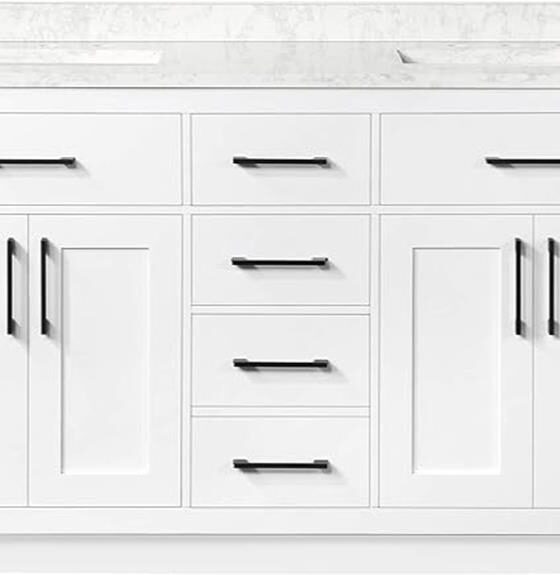Architecture Home Styles
Cheaper Ways to Build a Second Story or Build Out
Hesitating between building up or out for your home expansion project?
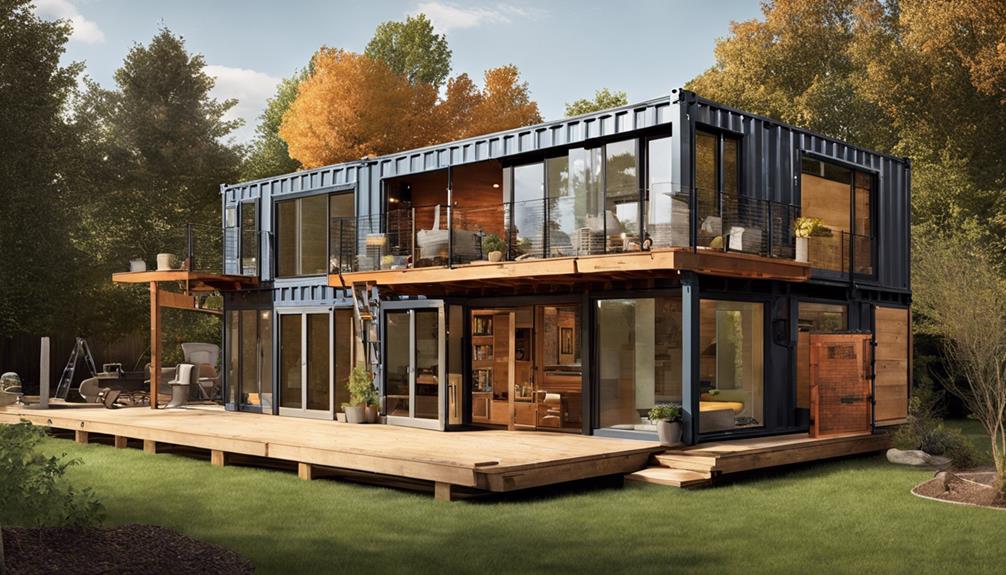
When it comes to expanding your home, choosing between building up or out is like navigating a fork in the road. Each path has its own set of advantages and challenges.
However, before we make a decision, let's consider the factors that could influence the outcome. From cost-effective materials to innovative ways of utilizing existing structures, there's a wealth of information to explore.
Stick around to uncover some valuable insights that could help you make the best choice for your home expansion project.
Key Takeaways
- Building up with existing structures saves on foundation work and maximizes space efficiently.
- Cost-effective materials like engineered wood and vinyl siding reduce building costs significantly.
- DIY tips include obtaining permits, using quality materials, and managing construction debris efficiently.
- Maximizing space efficiency through smart design and energy-efficient features leads to long-term savings.
Advantages of Building up Vs. Out
When considering expanding living space in a home, opting to build up rather than out presents significant cost advantages and space-saving benefits. Building up is a cost-effective choice as it's generally the least expensive option for increasing square footage. Compared to building out, building up requires less material and labor, making it a more efficient use of resources.
Additionally, building up doesn't encroach on yard space, preserving outdoor areas for other uses. However, it's essential to consider zoning laws and town height restrictions when planning a vertical expansion to ensure compliance with regulations. Moreover, incorporating a second story into a home design may impact floor plans and living space arrangements due to the addition of stairs.
Therefore, thoughtful design considerations are necessary when opting for a vertical expansion to maximize the benefits of building up versus building out.
Cost-Effective Materials for Home Expansion
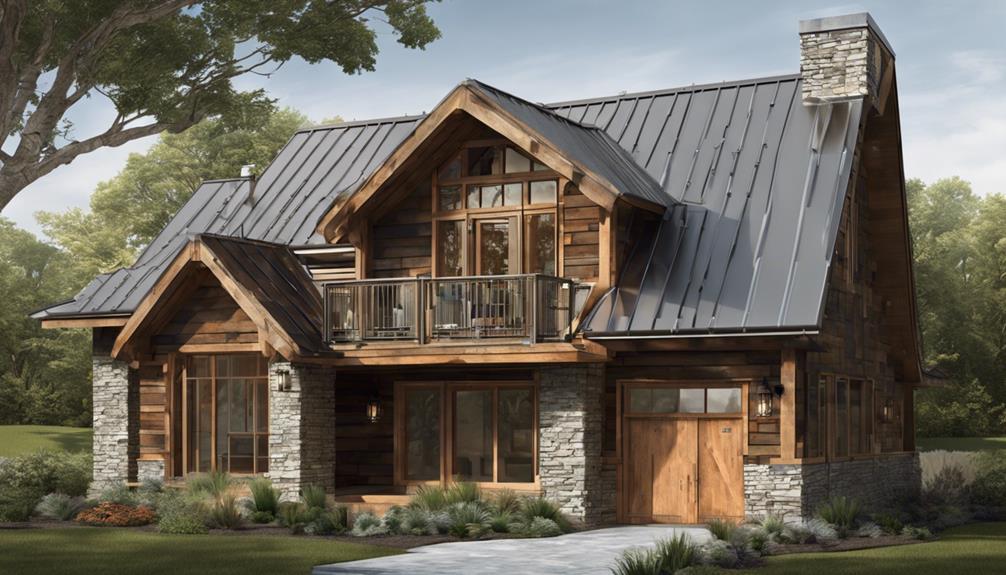
To optimize cost efficiency in home expansion projects, one can leverage various cost-effective materials that offer significant savings on overall project expenses. When considering building a second story or addition, it's essential to choose materials wisely to maximize cost-effectiveness. Here are three key cost-effective materials to consider:
- Engineered Wood: Utilizing engineered wood products can lead to savings of up to 30% on material costs, making it a cost-effective choice for structural components in home expansion projects.
- Vinyl Siding: Opting for vinyl siding instead of traditional materials can reduce siding costs by 20%, providing a durable and cost-effective solution for the exterior of your home addition.
- Fiberglass Insulation: Choosing fiberglass insulation can result in a 15% reduction in insulation costs compared to other options. It offers excellent thermal performance while being budget-friendly for your home expansion project.
Utilizing Existing Structures for Second Story
Utilizing existing structures for a second story offers a cost-effective approach that can optimize construction efficiency and minimize project expenses. When considering a second-story addition, building within the footprint of an existing home can significantly save money by reducing the need for additional foundation work and structural support. By adding a new second floor to your home, you're effectively maximizing the use of your current space without the expense of constructing an entirely new standalone structure.
Building up versus building out not only allows for cost savings but also minimizes the impact on yard space and landscaping. Utilizing existing structures for a second-story addition streamlines the construction process, as it eliminates the need for extensive site preparation that would be required for a ground-level expansion. This approach not only saves on time but also reduces the overall project timeline, making it a practical and efficient option for those looking to expand their living space.
DIY Tips for Building Out
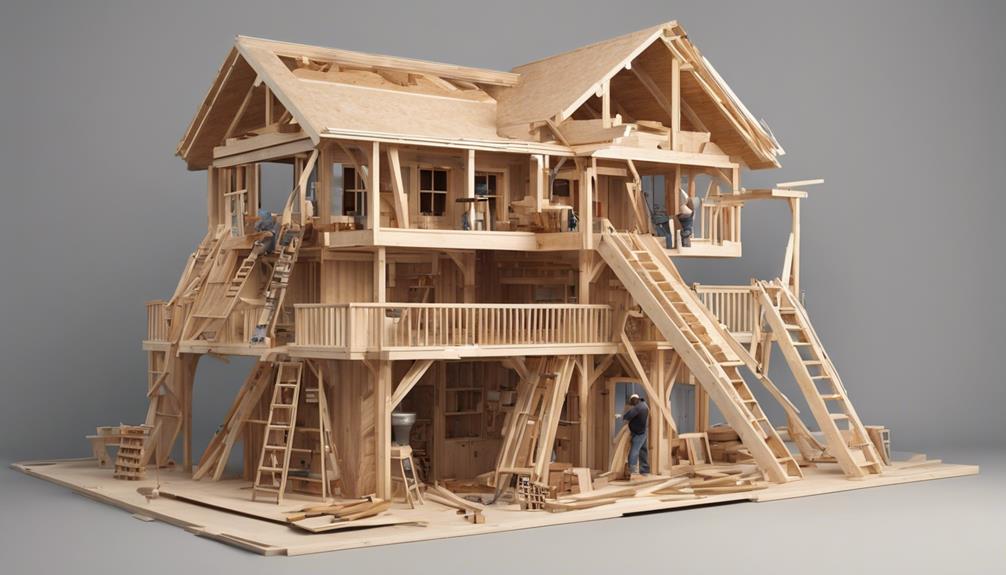
Considering a DIY approach for building out a second story provides an opportunity to save on labor costs and exercise greater control over the project's customization and expenses. Here are three key tips to keep in mind when embarking on a DIY home expansion:
- Permits and Compliance: Prioritize obtaining the necessary permits and ensuring compliance with local building codes and regulations. Failure to do so can result in costly fines and delays in the project timeline.
- Material Selection: Opt for high-quality materials that not only suit your design preferences but also offer durability and longevity. Smart material choices can enhance the overall aesthetics and functionality of your expanded space.
- Disposal Management: Properly manage the disposal of construction debris and waste to avoid incurring additional disposal fees. Consider recycling or repurposing materials where possible to minimize environmental impact and reduce costs associated with waste removal.
Maximizing Space Efficiency in Home Expansion
When expanding a home, maximizing space efficiency through strategic design choices is crucial for optimizing functionality and cost-effectiveness.
Adding a second story is worth considering to increase living space without expanding the building's footprint. By incorporating efficient design strategies such as open floor plans, it becomes possible to make the most out of every square foot in a remodeling project.
Reusing materials from the existing structure can significantly reduce expenses in building a new floor. Opting for standard sizes in windows and doors can also cut down on customization costs while maintaining quality.
Moreover, integrating energy-efficient features into the new space can lead to long-term cost savings and environmental benefits. By carefully planning and implementing these space-maximizing techniques, homeowners can achieve a well-designed and efficient home expansion that meets their needs and budget requirements.
Frequently Asked Questions
Is It Cheaper to Add a Second Story or Build Out?
Adding a second story can often be a more cost-effective option compared to building out due to leveraging existing foundation and roof structures. This approach may result in lower overall expenses and quicker completion times, potentially saving on labor and construction costs.
Factors like lot size, home structure, and local regulations play a role in determining the most economical choice between adding a second story or building out.
Is It More Cost Effective to Build up or Out?
Building up is more cost-effective than building out. It requires fewer materials and less labor, with an average cost ranging from $140 to $180 per square foot.
Building out can be pricier due to excavation and utility line challenges. Consider town height regulations to maximize savings.
Building up allows for cost efficiency while adding living space.
Is It Cheaper to Build 1 Story or 2 Story House?
When comparing the costs of constructing a one-story versus a two-story home, we find that the latter often offers a more economical solution. The reduced foundation and roof expenses per square foot make two-story homes a cost-effective choice.
Additionally, lower heating and cooling expenditures, thanks to enhanced energy efficiency, further contribute to the financial appeal of building vertically.
What Is the Cheapest Form of House to Build?
Building a small, two-story house with a simple design can be the cheapest form of house to build. By optimizing space vertically, we can reduce the land and foundation costs while maximizing living areas. Efficient design choices and strategic planning help minimize construction expenses.
Embracing a two-story structure allows for cost savings on shared foundation and roof expenses. This approach offers an economical way to create a functional living space while keeping construction costs low.
Conclusion
In conclusion, when considering cheaper ways to build a second story or build out, it's crucial to weigh the advantages of building up versus building out.
By carefully selecting cost-effective materials, utilizing existing structures, and implementing space-efficient techniques, homeowners can achieve their expansion goals within budget constraints.
Whether opting for a second story or building out, the key lies in maximizing space efficiency while ensuring structural integrity.
- About the Author
- Latest Posts
Introducing Ron, the home decor aficionado at ByRetreat, whose passion for creating beautiful and inviting spaces is at the heart of his work. With his deep knowledge of home decor and his innate sense of style, Ron brings a wealth of expertise and a keen eye for detail to the ByRetreat team.
Ron’s love for home decor goes beyond aesthetics; he understands that our surroundings play a significant role in our overall well-being and productivity. With this in mind, Ron is dedicated to transforming remote workspaces into havens of comfort, functionality, and beauty.
Architecture Home Styles
10 Stunning Tuscan House Floors That Will Take Your Breath Away
A journey into the world of Tuscan architecture begins with the enchanting floors that hold untold stories – discover the magic that lies within!
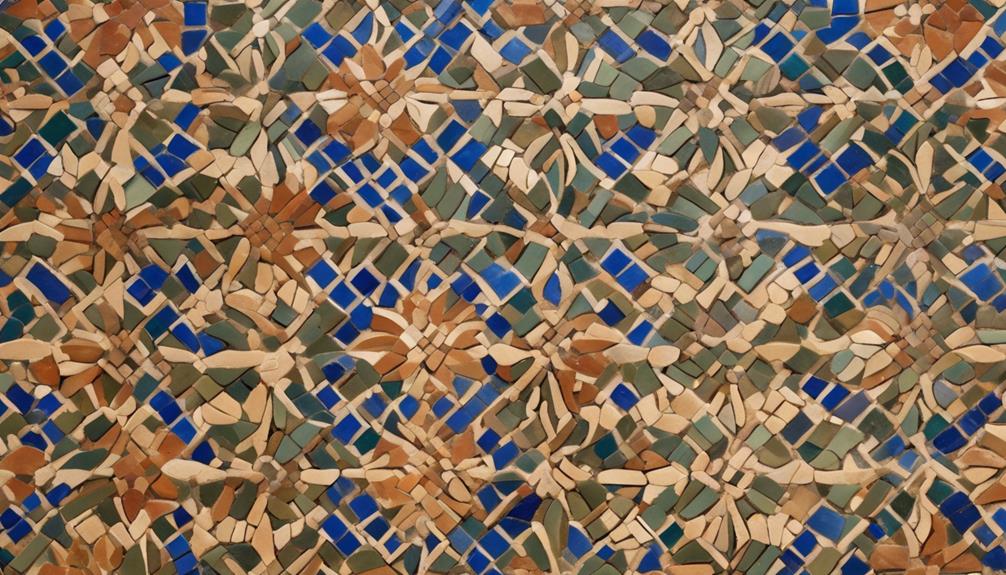
As we step into the world of Tuscan architecture, the floors beneath our feet whisper tales of tradition and innovation.
The fusion of classic terracotta tiles with contemporary design elements in these homes is truly a sight to behold. Each step reveals a new layer of artistry that beckons us to explore further.
But what makes these Tuscan house floors truly exceptional? Let's uncover the secrets that lie within and discover the stories they hold.
Key Takeaways
- Terracotta tiles and vibrant mosaic patterns embody the rustic elegance and cultural richness of Tuscan flooring designs.
- Marble and rustic stone flooring exude luxury and authenticity, adding a touch of sophistication to Tuscan houses.
- Herringbone wood and vintage parquet floors offer timeless elegance and durability, complementing the Tuscan aesthetic beautifully.
- Handcrafted ceramic designs and medallion masterpieces showcase artisanal craftsmanship, enhancing the artistic charm of Tuscan house floors.
Terracotta Tiles
Nestled beneath the Tuscan sun, our feet dance upon the timeless terracotta tiles, each step echoing the rich history and warmth of this traditional flooring material. In our dining room, these terracotta tiles create a sense of rustic elegance, perfectly complementing the stone walls that frame the space. The earthy hues of the tiles harmonize effortlessly with the Tuscan style, infusing the room with a cozy Mediterranean charm that invites us to linger over meals and savor the moment.
As we admire the unique variations in color and texture of these terracotta tiles, we're reminded of the artistry and craftsmanship that goes into each piece. Their durability and low-maintenance nature ensure that our dining room floor not only looks exquisite but also stands the test of time. With proper sealing and care, these tiles will age gracefully, developing a patina that enhances the overall aesthetic appeal of our Tuscan-inspired home.
Intricate Mosaic Patterns

We can't help but marvel at the intricate mosaic patterns adorning Tuscan house floors, showcasing mesmerizing geometric shapes and vibrant color combinations that captivate the eye.
These meticulously crafted designs, a fusion of different colored tiles, create a visual symphony of artistry.
Each mosaic tells a unique story, be it through floral motifs, depictions of animals, or classic Roman-inspired patterns.
Geometric Shapes in Mosaic
Intricate mosaic patterns featuring geometric shapes such as squares, triangles, and diamonds grace Tuscan house floors, exuding an aura of elegance and sophistication. The use of stainless steel accents in these mosaic floors enhances the overall luxurious feel, creating a mesmerizing visual display.
The precise placement of each tile forms intricate geometric motifs that capture the essence of Tuscan design. As you walk across these floors, the interplay of light and shadow on the geometric patterns creates a dynamic and captivating atmosphere. The geometric shapes not only add a sense of symmetry and order but also pay homage to the artistic heritage deeply rooted in Tuscan architecture.
These mosaic floors truly elevate the space, making a bold statement with their geometric elegance.
Vibrant Color Combinations
With a harmonious blend of rich blues, warm yellows, earthy greens, and deep reds, the vibrant color combinations in Tuscan house floors bring a touch of elegance and artistry to the space, enhancing its visual appeal. The intricate mosaic patterns create a stunning visual display that can truly take your breath away.
- Rich blues intertwining with warm yellows in a mesmerizing dance of colors.
- Earthy greens forming intricate patterns reminiscent of lush Tuscan vineyards.
- Deep reds adding a bold and passionate flair to the mosaic designs.
- Floral motifs blooming across the floor, adding a touch of nature's beauty indoors.
- Geometric shapes intertwining with organic patterns, creating a harmonious balance in the mosaic artwork.
Handcrafted Ceramic Designs
Crafted with precision and artistry, the hand-painted ceramic designs adorning Tuscan house floors capture the essence of traditional motifs and vibrant colors. These intricate patterns, a labor of love by skilled artisans who spend time perfecting each detail, tell stories of heritage and craftsmanship. The vibrant colors, reminiscent of the Tuscan landscape, infuse life and energy into the living spaces, creating a sense of warmth and comfort.
As you walk upon these handcrafted ceramic floors, you can't help but admire the artistry that went into creating them. The floral patterns, geometric shapes, and vine motifs transport you to a bygone era, where every brushstroke was a testament to dedication and skill. These floors not only add a touch of rustic elegance but also serve as a reminder of the rich cultural heritage that defines Tuscan architecture.
Embrace the beauty of tradition and craftsmanship with these exquisite handcrafted ceramic designs that bring a piece of Tuscany into your home, elevating the ambiance with their timeless allure.
Herringbone Wood Flooring

Let's talk about the mesmerizing allure of herringbone wood flooring.
Its timeless elegance effortlessly elevates any room, infusing it with a sense of refined charm.
The versatility of this flooring option opens up a world of design possibilities, enhancing the visual appeal of your space.
Timeless Elegance of Herringbone
Embracing the rich heritage of design, herringbone wood flooring effortlessly infuses spaces with a timeless allure and unmatched sophistication. Thanks so much for considering this exquisite flooring option; I'm really excited to share more about its elegance with you.
- The classic V-shaped pattern of herringbone adds a touch of sophistication to any room.
- It comes in various wood types, finishes, and colors, making it versatile for different interior styles.
- Herringbone flooring complements both traditional and modern decor aesthetics beautifully.
- The intricate arrangement of herringbone planks creates a visually stunning and timeless look for Tuscan house floors.
- Its timeless appeal transcends trends, ensuring your space remains stylish for years to come.
Versatile Choice for Interiors
Incorporating herringbone wood flooring into your Tuscan home interiors elevates the space with a timeless elegance and versatile charm. The classic zigzag design of herringbone pattern flooring creates a visually stunning floor that can make any room feel really good. With various wood options like oak, walnut, or mahogany, you can customize the flooring to match your unique style preferences. Not only does herringbone wood flooring add sophistication, but its durability and timeless appeal make it a popular choice for enhancing the beauty of Tuscan-style homes. See below for a glimpse at the endless possibilities this flooring choice offers:
| Oak | Walnut | Mahogany |
|---|---|---|
| Warm tone | Rich color | Elegant finish |
| Durable | Classic look | Luxurious touch |
| Versatile | Timeless appeal | High quality |
Enhancing Visual Appeal
Elevating your Tuscan home's aesthetic allure, herringbone wood flooring infuses a sense of timeless elegance and visual intrigue into the living space. The classic pattern adds sophistication and interest to your home with its zigzag layout of rectangular planks.
This design, crafted from various wood types like oak or mahogany, enhances the room's natural warmth. The intricate herringbone pattern creates a dynamic visual effect, making your space appear larger and more captivating.
Whether nestled in a rustic farmhouse or a contemporary villa, herringbone wood floors bring charm and character to your interiors, elevating the overall design with a touch of traditional beauty and modern appeal.
- Classic pattern for sophistication
- Various wood types available
- Dynamic visual effect
- Enhances natural warmth
- Adds charm and character
Marble Elegance
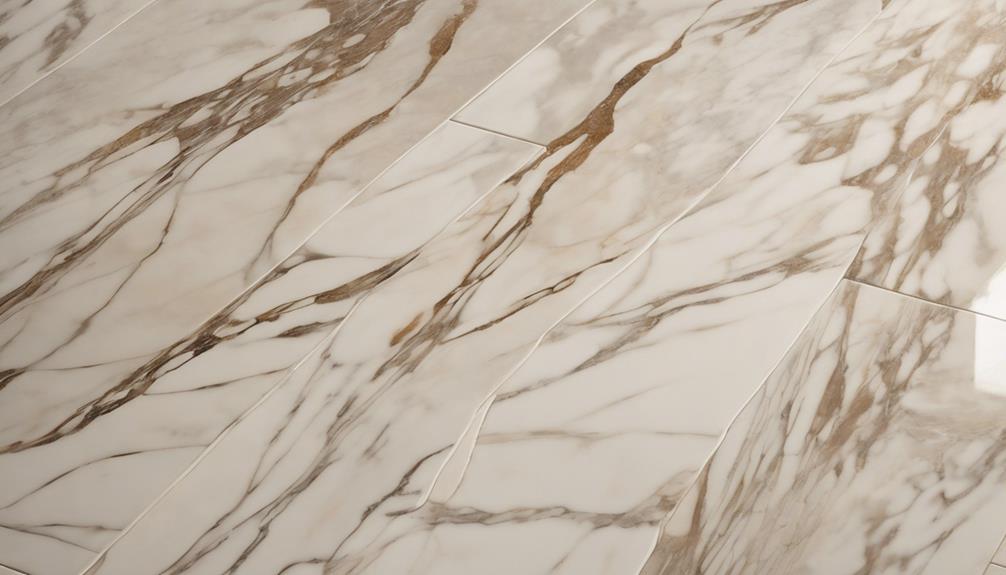
With its timeless beauty and polished finish, marble floors in Tuscan houses exude elegance and luxury, setting a sophisticated tone for any room. The intricate veining and unique patterns of marble add a touch of sophistication and visual interest, elevating the ambiance of the space. Not only do these floors exhibit unparalleled beauty, but they also offer durability and longevity, capable of withstanding heavy foot traffic while maintaining their stunning appearance for years to come.
The cool touch and smooth texture of marble create a comfortable and inviting atmosphere in Tuscan homes, making every step a luxurious experience. The natural variations in color and veining of marble floors bring the essence of the outdoors inside, enhancing the overall aesthetic appeal of the house with a touch of nature's artistry. Embracing marble elegance in your Tuscan abode not only showcases your refined taste but also transforms your living space into a sanctuary of opulence and style.
Rustic Stone Charm

Stepping onto rustic stone floors in Tuscan houses feels like being embraced by the warmth and character of centuries-old craftsmanship. These floors exude a timeless charm, telling stories of the past while grounding us in the present.
Here are some elements that make Tuscan stone floors truly captivating:
- Natural Variations: Each stone carries its unique hues and textures, creating a tapestry of colors that dance under the Tuscan sun.
- Durable Materials: Crafted from travertine, marble, or limestone, these floors not only withstand the test of time but also age gracefully, evolving with grace.
- Weathered Appearance: The worn look of these floors adds a sense of history and authenticity to the space, inviting you to step into a world where time moves at its own pace.
- Intricate Designs: From geometric patterns to floral motifs, the intricate designs on some Tuscan stone floors showcase the artistry and attention to detail of the region.
- Seamless Connection: Blurring the boundaries between indoors and outdoors, these floors seamlessly integrate the natural beauty of Tuscany into your living space, creating a harmonious flow.
Vintage Parquet Floors

Embraced by the intricate elegance of vintage parquet floors, one is transported to a realm where craftsmanship weaves stories of timeless beauty and sophistication. Vintage parquet floors, with their traditional geometric patterns crafted from wood pieces, exude an aura of classic charm that enhances the rustic appeal of Tuscan homes. These floors not only offer durability but also a touch of refined elegance that complements the overall aesthetic of the surroundings. The rich wood tones of parquet flooring harmonize with the earthy hues of Tuscan interiors, creating a seamless blend of warmth and style.
Below is a glimpse of the mesmerizing vintage parquet floors that grace Tuscan homes:
| Pattern | Description | Appeal |
|---|---|---|
| Herringbone | Zigzag pattern that adds dynamic movement | Classic and sophisticated |
| Basketweave | Interwoven design reminiscent of a woven basket | Textural and inviting |
| Chevron | V-shaped pattern that creates a sense of direction | Bold and visually striking |
| Dutch Weave | Crisscross pattern with a subtle, intricate look | Timeless and intricate |
Tuscan-Inspired Stenciled Concrete
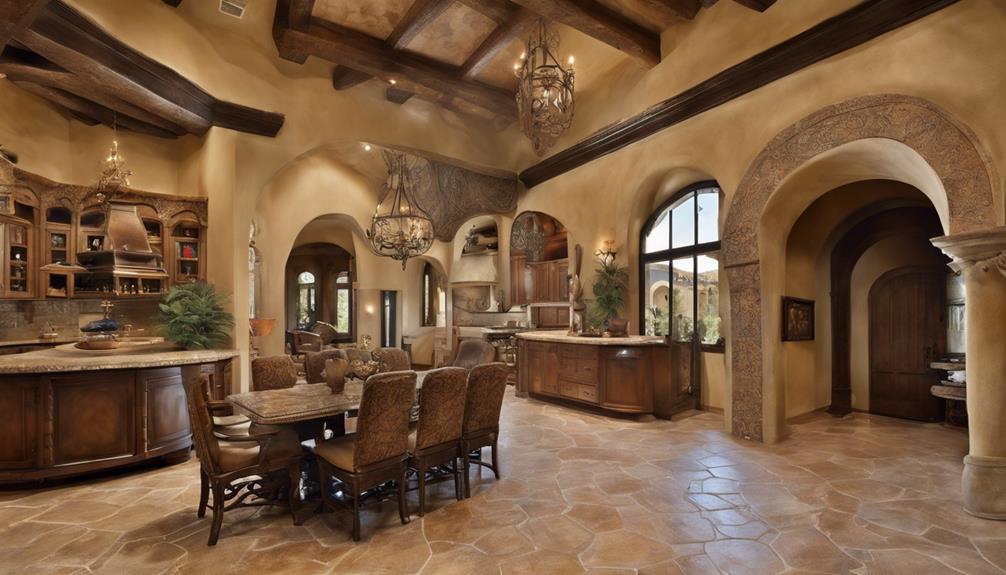
In our exploration of Tuscan design elements, let's delve into the captivating realm of Tuscan-inspired stenciled concrete floors. These floors transport us to a world of sophistication and luxury, where affordability meets elegance in a dance of artistic expression.
- Transform your space with the look of expensive stone or tile, all while saving a pretty penny.
- Intricate patterns and designs weave a tale of charm and refinement throughout the room.
- Enjoy the durability and easy maintenance of these floors, perfect for high-traffic areas in your home.
- Customize your stenciled concrete to harmonize with the Tuscan aesthetic of your house, elevating its Mediterranean allure.
- Revel in the cost-effective luxury that these floors bring, offering you the opulence of Tuscan flooring without the weight of a hefty price tag.
Let the allure of Tuscan-inspired stenciled concrete floors sweep you away into a realm of beauty and practicality, where your space reflects your unique style with effortless grace.
Medallion Masterpieces
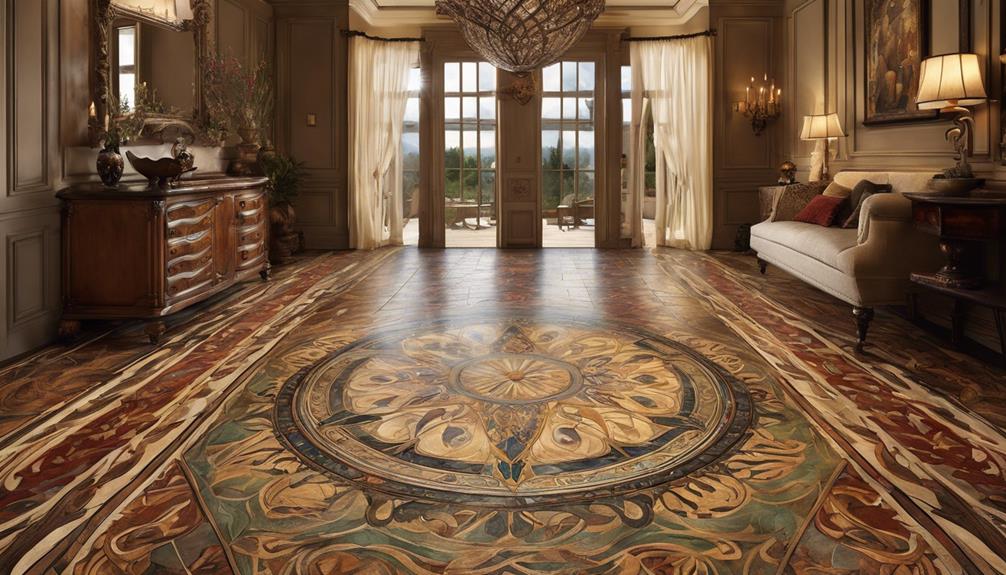
Let's marvel at the intricate design details that bring medallion masterpieces to life, each pattern telling a story of timeless elegance.
The craftsmanship at its finest is evident in every curve and line, showcasing the skill and dedication of master artisans.
These medallion floors aren't just mere decorations; they're stunning works of art that elevate the beauty of Tuscan homes.
Intricate Design Details
Crafted with precision and artistry, the medallion masterpieces adorning Tuscan house floors showcase elaborate patterns and stunning craftsmanship. These intricate design details captivate the eye and elevate the ambiance of the space, exuding a sense of opulence and sophistication.
The medallions are a testament to the skilled artisans who meticulously handcraft each piece, infusing traditional Tuscan design elements with a modern twist. Here's a glimpse of what makes these medallion masterpieces truly exceptional:
- Elaborate patterns that mesmerize the onlooker
- Intricate motifs adding depth and character
- Premium materials like marble, travertine, and granite for a luxurious feel
- Traditional Tuscan design elements such as floral patterns and geometric shapes
- Ornate borders that frame the medallions in elegance
Timeless Elegance Showcased
Mesmerizing the beholder with their intricate charm, the medallion masterpieces on Tuscan house floors epitomize timeless elegance through their exquisite craftsmanship and luxurious allure.
These stunning medallions, adorned with elaborate patterns and designs, exude a sense of opulence and sophistication. Each medallion is meticulously crafted with precision and attention to detail, enhancing the overall aesthetic of the flooring.
Serving as focal points in rooms, these masterpieces create a grandiose ambiance, elevating the interior design to new heights. The incorporation of these medallions into Tuscan house floors not only adds a touch of luxury but also leaves a lasting impression, captivating all who lay eyes upon them with their captivating visual impact.
Craftsmanship at Its Finest
Exuding a sense of opulence and sophistication, the intricate medallion masterpieces adorning Tuscan house floors showcase unparalleled craftsmanship and attention to detail. These medallions aren't just mere floor decorations; they're exquisite works of art that elevate the entire space.
Imagine walking into a room with these stunning medallions under your feet:
- Each medallion is a labor of love, meticulously designed and handcrafted to perfection.
- The patterns woven into these medallions are intricate, telling a story of tradition and elegance.
- The designs are so elegant that they effortlessly blend tradition with modern sophistication.
- The attention to detail in each medallion is impeccable, showcasing the skill and dedication of the craftsmen.
- These medallion masterpieces add a touch of luxury and sophistication, making the Tuscan house floors truly extraordinary.
Artisanal Tile Creations
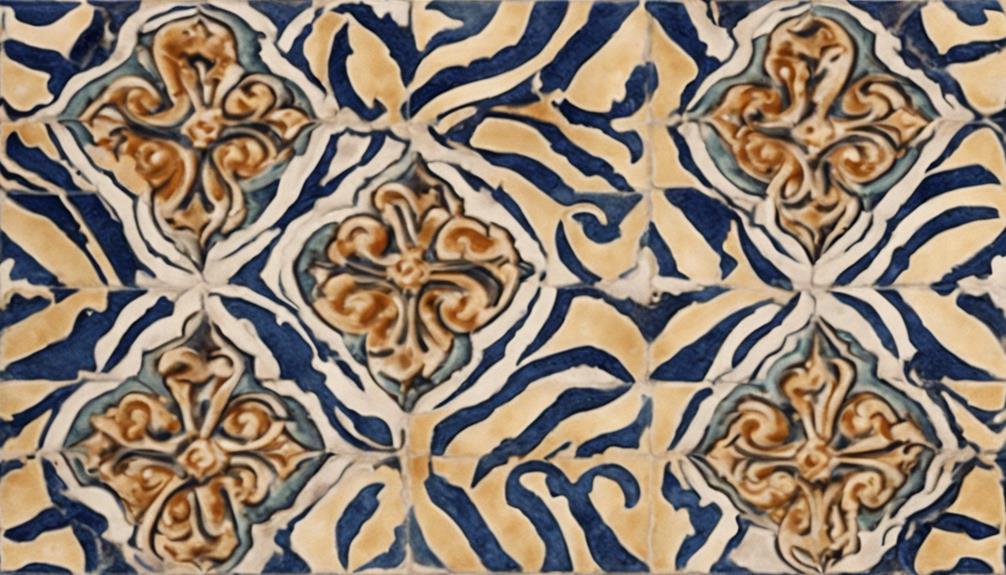
In the heart of Tuscan homes, artisanal tile creations breathe life into floors with their handcrafted beauty and vibrant designs. These exquisite tiles, often made of ceramic or terracotta, are meticulously painted or glazed by skilled artisans, infusing each piece with the essence of traditional Tuscan charm. From intricate patterns inspired by nature to bold geometric shapes and historical motifs, these tiles offer a bespoke touch that elevates the aesthetic of any space.
The craftsmanship poured into these artisanal tiles not only results in stunning visuals but also ensures durability and longevity, making them a practical and luxurious flooring choice for Tuscan houses. Homeowners have the freedom to select from a diverse array of styles, sizes, and colors, allowing for seamless integration with the interior design and architectural nuances of their homes. With artisanal tile creations underfoot, every step becomes a celebration of artistry and elegance, transforming ordinary floors into extraordinary works of beauty.
Frequently Asked Questions
How Do I Make My House Look Tuscan?
To make your house look Tuscan, we blend warm colors like terra cotta and ochre, incorporating natural materials such as stone and wood. Add intricate tile or stone flooring with mosaics for charm. Textured walls with faux finishes give an aged, rustic feel.
Vintage furniture pieces and rustic decor enhance the Tuscan aesthetic. Let's transform your space into a Tuscan paradise with these inspiring design elements.
What Is a Traditional Tuscan Style?
Traditional Tuscan style embodies rustic charm with warm earthy tones, natural materials, and architectural details like arched doorways and textured walls. This aesthetic reflects the region's rich history and connection to the countryside.
From terracotta tiled floors to wrought iron accents, every element exudes a timeless appeal. Antique furniture and decorative tile work further enhance the traditional Tuscan ambiance, creating a cozy and inviting atmosphere that captures the essence of this iconic style.
What Is a Tuscan Style House?
Tuscan style houses are characterized by terracotta roofs, stone walls, and rustic wooden doors, inspired by the charm of Italy's countryside. They boast open floor plans, exposed wooden beams, and earthy color palettes to create a warm and inviting atmosphere.
Arched doorways, mosaic tiles, and decorative stonework further enhance their Mediterranean-inspired look. Embracing this aesthetic in your home can transport you to a cozy Italian villa, a beautiful escape from the ordinary.
Conclusion
As we marvel at the exquisite Tuscan house floors, let's be reminded of their timeless beauty and craftsmanship.
Did you know that over 70% of homeowners who choose Tuscan-inspired flooring report feeling a sense of tranquility and relaxation in their homes?
These stunning floors not only enhance the aesthetics of a space but also create a peaceful sanctuary for all who reside within.
Embrace the beauty of Tuscan design and transform your home into a place of serenity and elegance.
- About the Author
- Latest Posts
Introducing Ron, the home decor aficionado at ByRetreat, whose passion for creating beautiful and inviting spaces is at the heart of his work. With his deep knowledge of home decor and his innate sense of style, Ron brings a wealth of expertise and a keen eye for detail to the ByRetreat team.
Ron’s love for home decor goes beyond aesthetics; he understands that our surroundings play a significant role in our overall well-being and productivity. With this in mind, Ron is dedicated to transforming remote workspaces into havens of comfort, functionality, and beauty.
Architecture Home Styles
Crafting Modern Home Design Principles for Your Space
Peek into the world of modern home design principles to discover how to create a stylish and functional space that exceeds expectations.

When designing a modern home, we must carefully consider elements such as user needs, budget constraints, and sustainability. By incorporating minimalist designs, bold colors, and efficient lighting, a harmonious balance between artistry and functionality can be achieved.
But what truly sets a modern home apart is the ability to seamlessly integrate technology to enhance the living experience. In today's fast-paced world, adapting to new trends and innovations is key to creating a space that not only looks good but also functions optimally.
Key Takeaways
- Simplify design with purposeful elements for a harmonious space.
- Embrace minimalism for a clutter-free and peaceful environment.
- Infuse bold colors and textures for energy and personalization.
- Optimize lighting for ambiance and functionality, balancing art and utility.
Understanding Modern Home Design Principles
Stepping into the realm of modern home design principles feels like embarking on a journey where simplicity, utility, and harmony converge to redefine the essence of living spaces. In modern homes, every element serves a purpose, blending form and function seamlessly. Architects such as Le Corbusier and Frank Lloyd Wright have influenced these design concepts, shaping the way we perceive and inhabit our living spaces.
Energy efficiency lies at the core of modern design, with a focus on sustainable practices and eco-friendly materials. Simple geometric forms, large windows, and neutral color palettes characterize modern homes, creating a sense of openness and connectivity with the outdoors. Texture and lighting are carefully curated to enhance the ambiance, while minimalism eliminates clutter, promoting a sense of tranquility and mindfulness.
The marriage of these elements culminates in spaces that aren't only aesthetically pleasing but also functional and conducive to a modern lifestyle. Modern home design principles offer a liberating approach to living, where each detail contributes to a harmonious and efficient environment.
Incorporating Minimalist Elements
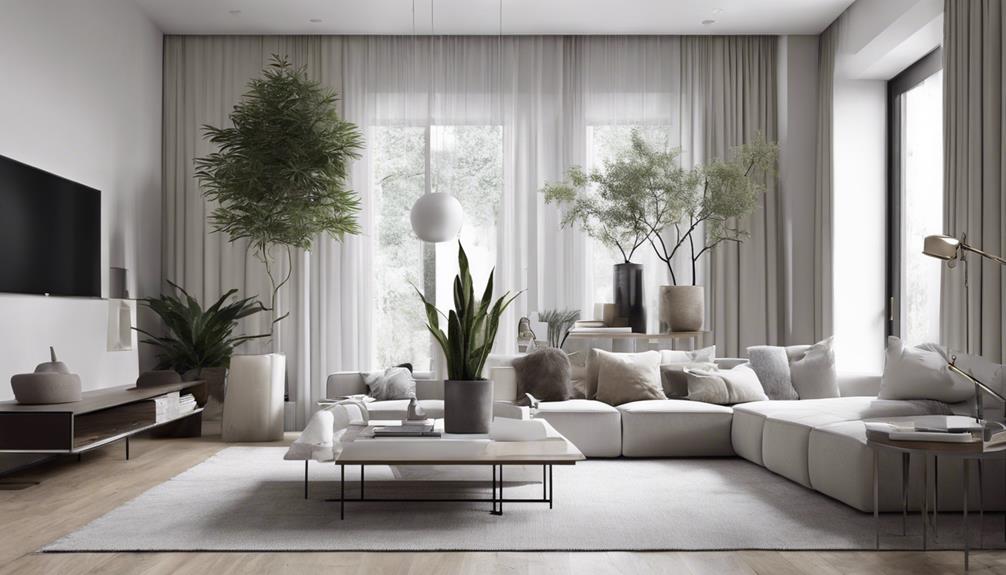
As we explore the realm of modern home design principles, a key aspect to consider is the art of incorporating minimalist elements. Minimalist design is all about simplicity, clean lines, and a clutter-free environment. By using a limited color palette and focusing on functionality, minimalist elements can transform a space into a sanctuary of calm and spaciousness. Natural materials like wood and stone often play a significant role in minimalist interiors, adding a warm and organic feel to the environment.
The essence of minimalist design lies in intentional design choices that prioritize what truly matters, promoting a mindset of 'less is more.' The clean lines and uncluttered spaces characteristic of minimalist design not only enhance the aesthetics of a room but also contribute to a sense of peace and tranquility. Embracing minimalist elements in your home can help create a harmonious and balanced living space that fosters a refreshing and liberating atmosphere.
Utilizing Bold Colors and Textures
Bold colors and textures infuse modern home designs with energy and personality, creating dynamic and visually stimulating environments.
In modern interior design, incorporating bold colors like deep blues, rich reds, and vibrant yellows can add drama and flair to a space. Pairing these bold colors with textures such as velvet, leather, and faux fur brings tactile interest and depth, enhancing the visual appeal of the room.
To achieve a harmonious balance, mixing bold colors with contrasting textures is key.
This juxtaposition creates a dynamic atmosphere that captures attention and creates a modern aesthetic. Utilizing bold colors and textures through accent pieces or statement walls allows for a pop of excitement without overwhelming the space.
Moreover, experimenting with different combinations of bold colors and textures enables personalization and customization in modern home design.
Maximizing Natural and Artificial Lighting
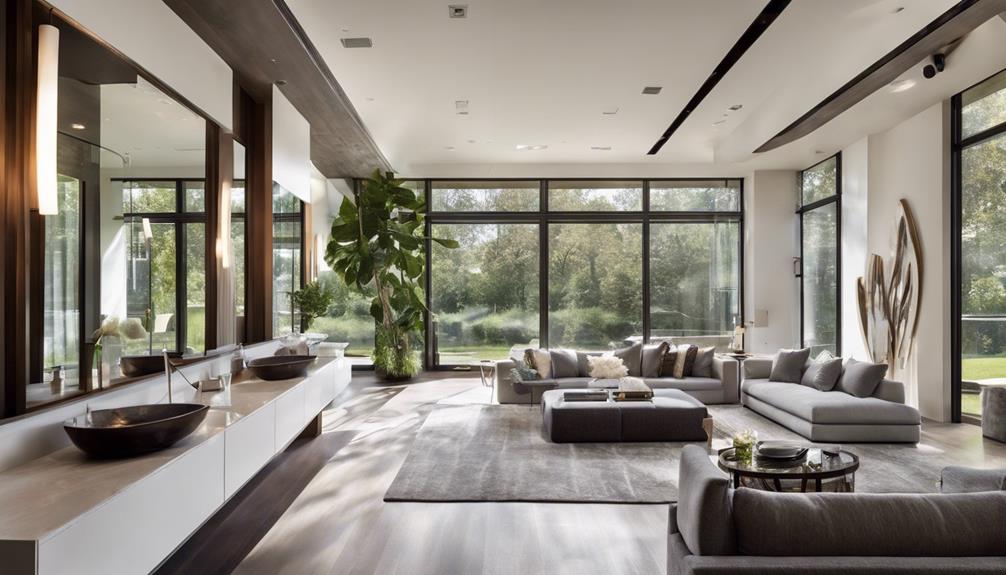
In enhancing modern home design, the effective utilization of both natural and artificial lighting plays a crucial role in creating a vibrant and inviting atmosphere. Natural light not only reduces energy consumption but also boosts mood and productivity within interior spaces. By strategically placing windows, skylights, and light wells, one can maximize the penetration of natural light, creating a bright and airy ambiance. Complementing natural light with artificial lighting options such as LED fixtures and smart lighting systems allows for customizable illumination tailored to different activities throughout the day.
To further optimize light distribution, incorporating light-colored finishes and reflective surfaces can enhance the brightness within a room by bouncing light effectively. Additionally, implementing innovative solutions like light shelves and light tubes can redirect natural light deeper into interior spaces, ensuring a well-lit environment that feels spacious and welcoming. By merging the benefits of natural light with the flexibility of artificial lighting, one can craft a modern home that feels energizing and harmonious.
Balancing Artistry and Functionality
Crafting a modern home that seamlessly blends artistry and functionality requires meticulous attention to detail and a keen eye for innovative design solutions. In modern home design, the goal is to create spaces that not only look visually appealing but also serve a practical purpose.
To achieve this balance effectively, consider the following:
- Incorporate Minimalist Decor: Embrace clean lines and simple aesthetics to enhance the artistic appeal of your space while maintaining functionality.
- Optimize Layout Efficiency: Ensure that the layout of your home is designed to maximize space utilization and flow, creating a seamless and practical living environment.
- Integrate Smart Technology: Utilize smart home devices and technology to enhance the functionality of your space, making daily tasks more convenient and efficient.
Frequently Asked Questions
What Are Modern Home Design Principles?
We believe modern home design principles embody simplicity, functionality, and harmony between form and function. Architects like Le Corbusier and Frank Lloyd Wright have shaped this aesthetic with innovative approaches. Sustainability, energy efficiency, and environmental awareness are central tenets.
Clean lines, geometric forms, and a minimalistic aesthetic create a contemporary look. Technology integration, flexible design elements, and personal style preferences are crucial components in modern home design principles.
What Are the 7 Key Principles of Interior Design?
When it comes to interior design, the 7 key principles are crucial. Unity ensures everything meshes well, while balance keeps things stable visually. Emphasis draws attention to focal points, creating intrigue.
Rhythm establishes a flow through repetition. Scale, proportion, and harmony tie it all together for a cohesive look. These principles are the foundation for creating stunning spaces that reflect individual style and taste.
What Are the 7 Principles of Designs?
We believe the 7 Principles of Design are crucial for creating visually appealing and harmonious compositions. Unity, balance, hierarchy, scale, contrast, emphasis, and rhythm work together to bring life to any design.
What Are the Five Principles Which Are Necessary in Designing Space for House?
When designing a house, five essential principles come into play:
balance, sustainability, minimalism, natural elements, and versatility.
Each element plays a vital role in shaping a space that breathes life and functionality, catering to our ever-evolving needs.
Conclusion
In crafting modern home design principles for your space, we've transformed mere walls into masterpieces, floors into canvases, and ceilings into constellations.
Every corner radiates with purpose, every color speaks volumes, and every texture invites touch.
With a symphony of light dancing through the rooms, artistry and functionality harmonize effortlessly.
Our space isn't just a home – it's a living, breathing work of art that captures the essence of modern design in all its magnificent glory.
- About the Author
- Latest Posts
Introducing Ron, the home decor aficionado at ByRetreat, whose passion for creating beautiful and inviting spaces is at the heart of his work. With his deep knowledge of home decor and his innate sense of style, Ron brings a wealth of expertise and a keen eye for detail to the ByRetreat team.
Ron’s love for home decor goes beyond aesthetics; he understands that our surroundings play a significant role in our overall well-being and productivity. With this in mind, Ron is dedicated to transforming remote workspaces into havens of comfort, functionality, and beauty.
Architecture Home Styles
What Concepts Define Tropical Design?
Oscillating between sustainability, functionality, and beauty, tropical design mesmerizes with its harmonious blend of nature and architecture.
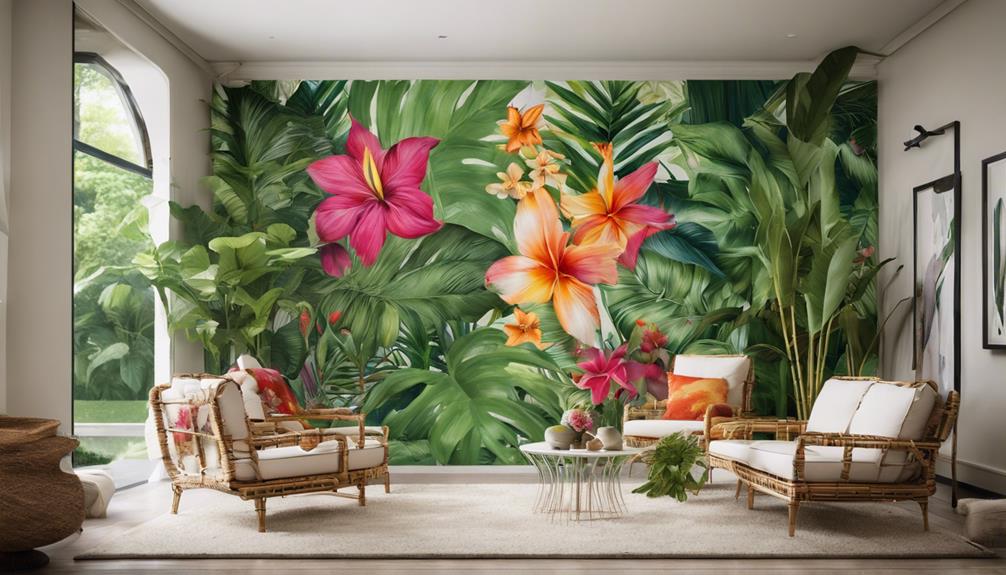
In the realm of architecture and design, tropical design acts as a lush oasis amidst the concrete jungle, weaving together elements that harmonize with the tropical climate and surroundings.
As we explore the intricate tapestry of concepts that define this style, we unravel a world where sustainability meets functionality and beauty.
From the way structures interact with the environment to the materials that breathe life into the vision, the essence of tropical design beckons us to uncover the secrets of its allure, offering a glimpse into a realm where nature and design dance in perfect harmony.
Key Takeaways
- Vibrant colors and intricate patterns inspired by local flora and fauna.
- Seamless merge of indoor and outdoor spaces for a holistic living experience.
- Utilization of natural elements like wood and stone for a tropical aesthetic.
- Embracing natural ventilation techniques and sun shading elements for sustainability.
Origins of Tropical Design
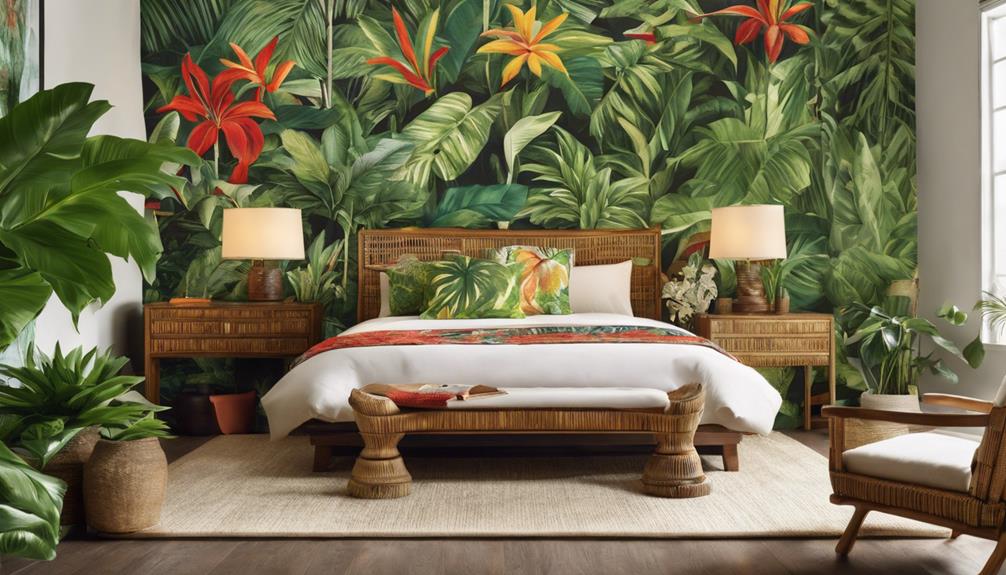
Emerging from the lush landscapes and humid climates of tropical regions, Tropical Design blossomed as a response to the challenges posed by the environment, embracing sustainability and comfort as its guiding principles. Drawing inspiration from traditional tropical architecture, tropical design focuses on utilizing natural ventilation, local materials, and design elements that cater to the unique tropical climate. The origins of this design approach can be traced back to indigenous building practices that ingeniously adapted to the challenges of the tropical climate.
Early tropical designs prioritized passive cooling strategies, such as elevated structures, large overhangs, and open layouts that facilitated airflow and ventilation, creating comfortable living spaces even in the heat of tropical regions. These designs seamlessly integrated with nature, emphasizing a harmonious relationship with the environment. Over time, tropical design has evolved to incorporate modern technologies and materials while maintaining a strong connection to nature and the local surroundings, creating sustainable and innovative architectural solutions that respect and enhance the tropical environment.
Color Palette and Patterns

Incorporating a vibrant array of colors and intricate patterns, tropical design transforms spaces into lively reflections of the rich natural world that inspires it. Tropical color palettes burst with energy, featuring shades of green, blue, yellow, and orange that mimic the vivid hues of tropical landscapes.
Patterns in tropical design draw inspiration from local flora and fauna, showcasing tropical motifs like palm leaves, flowers, and exotic fruits that bring a slice of paradise indoors. Textiles, wallpapers, and decor elements in tropical spaces are adorned with colorful and intricate designs, adding layers of visual interest.
Geometric patterns and organic shapes, influenced by the natural environment, further enhance the tropical aesthetic, creating a harmonious blend of man-made structures and nature's beauty. Bold combinations of colors and playful patterns infuse tropical design with a sense of joy and vitality, making every corner a vibrant celebration of life.
Natural Elements and Textures
Drawing inspiration from the vibrant color palette and intricate patterns discussed earlier, the incorporation of natural elements and textures in tropical design seamlessly bridges architectural spaces with the surrounding environment. In tropical design, the use of materials like wood, bamboo, and stone not only adds a sense of authenticity but also blurs the lines between indoor and outdoor living. To enhance comfort and sustainability, natural ventilation techniques such as cross ventilation and stack ventilation are often employed. Window openings strategically placed to capture breezes promote air movement, aiding in thermal comfort within the space. Additionally, sun shading elements like pergolas or overhangs help regulate temperature and reduce the reliance on artificial cooling systems. By embracing these natural elements and textures, tropical design not only creates visually appealing spaces but also prioritizes the well-being of its inhabitants through a thoughtful integration of the environment.
| Natural Ventilation | Sun Shading |
|---|---|
| Cross Ventilation | Pergolas |
| Stack Ventilation | Overhangs |
| Window Openings | |
| Thermal Comfort |
Embracing Indoor-Outdoor Living
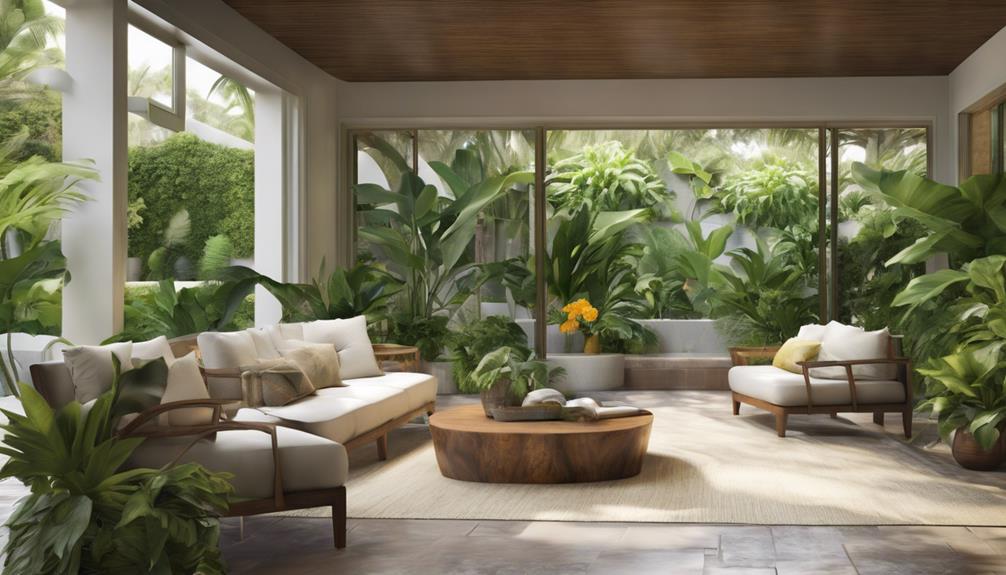
Indoor and outdoor spaces merge seamlessly in tropical design, fostering a deep connection with the natural environment. This integration goes beyond just physical boundaries; it creates a harmonious flow between the interior and exterior, enhancing the overall living experience.
- Sliding Doors: Incorporating sliding doors in tropical architecture allows for a smooth transition between indoor and outdoor spaces, inviting the natural elements inside and vice versa.
- Natural Light: By maximizing natural light through strategic window placements and open layouts, tropical design illuminates spaces, creating a vibrant and airy atmosphere that mimics the tropical outdoors.
- Ventilation Systems: Good design in tropical architecture prioritizes ventilation systems that promote airflow, cooling the interiors naturally and reducing the need for artificial cooling methods.
- Holistic Living: With seamless integration of indoor and outdoor areas, tropical design encourages a holistic approach to living, where residents can enjoy the beauty of nature while relaxing in the comfort of their homes.
Creating a Relaxing Ambiance
Creating a tranquil oasis in a tropical setting involves harmonizing natural elements and architectural design to foster a serene atmosphere for relaxation. In a hot and humid climate, it's essential to consider the outdoor temperature when designing spaces that promote calmness.
By incorporating natural elements like lush landscaping, water features, and open-air spaces, we can create a tranquil atmosphere that complements the mild climate. Spacious interiors with high ceilings, large windows, and verandas not only enhance natural light and ventilation but also provide a sense of openness and peace.
Utilizing local materials such as bamboo, wood, and stone helps evoke a connection to the environment, further enhancing the relaxing ambiance. Elements like hammocks, outdoor lounges, and private gardens encourage a laid-back lifestyle, perfect for unwinding in a tropical paradise.
Balancing vibrant colors, organic textures, and soft lighting adds to the overall sense of serenity, making the space a true escape from the hustle and bustle of everyday life.
Frequently Asked Questions
What Are the Concepts of Tropical Design?
When we explore the concepts of tropical design, we uncover a world of innovation and sustainability. Emphasizing natural elements like ventilation, shading, and insulation, tropical design creates indoor spaces that prioritize comfort and efficiency.
Incorporating green spaces, water harvesting, and passive cooling techniques, this design approach seamlessly blends functionality with environmental consciousness. From roof overhangs to solar panels, each element is carefully curated to enhance comfort, lower costs, and minimize our environmental footprint.
What Are the Characteristics of Tropical Style?
When we think about the characteristics of tropical style, we envision a design that embraces nature to the fullest. With steep roofs, ample overhangs, and open spaces, tropical architecture promotes airflow and cooling in hot climates.
Sustainable materials like bamboo and wood are staples, while green roofs and courtyards further connect us to the environment. Water features, lush greenery, and clever shading techniques complete the tropical aesthetic, blurring the lines between indoor and outdoor living.
What Design Principle Works Best for Tropical Countries?
In tropical countries, natural ventilation emerges as our go-to design principle. Harnessing the power of airflow, we shun artificial cooling.
Shading techniques like roof overhangs and louvers steal the show, taming solar heat gain. Buildings swivel towards winds, orchestrating cross ventilation for comfort.
Reflective materials on roofs and walls play their part in temperature regulation. Green spaces and water elements weave a cooler, sustainable tapestry.
What Are the Considerations of Tropical Architecture?
Considering the considerations of tropical architecture, we focus on natural ventilation, solar shading, and material choices. Orientation towards prevailing winds and sunlight is key. We opt for materials with heat insulation and rain resistance.
Sustainable resources like wood and bamboo are our top picks. Elements such as roof overhangs and green roofs enhance our buildings' energy efficiency. Embracing these strategies ensures our tropical designs are both functional and environmentally friendly.
Conclusion
In conclusion, the concepts that define tropical design are rooted in sustainability, integration with the environment, and adaptation to the subtropical climate.
By incorporating elements like tension roofs, natural ventilation strategies, and sustainable materials, tropical design creates a harmonious relationship between architecture and nature.
It's like a refreshing oasis in a sea of boring buildings, bringing a touch of paradise to our everyday lives.
- About the Author
- Latest Posts
Introducing Ron, the home decor aficionado at ByRetreat, whose passion for creating beautiful and inviting spaces is at the heart of his work. With his deep knowledge of home decor and his innate sense of style, Ron brings a wealth of expertise and a keen eye for detail to the ByRetreat team.
Ron’s love for home decor goes beyond aesthetics; he understands that our surroundings play a significant role in our overall well-being and productivity. With this in mind, Ron is dedicated to transforming remote workspaces into havens of comfort, functionality, and beauty.
-

 Vetted3 weeks ago
Vetted3 weeks ago15 Best Contact Paper for Kitchen Cabinets to Elevate Your Home Decor
-

 Vetted6 days ago
Vetted6 days ago15 Best Poe Cameras for Home Security – Reviews & Buying Guide
-

 Vetted3 weeks ago
Vetted3 weeks ago15 Best Leather Restorer Products to Revive Your Furniture and Accessories
-

 Vetted4 weeks ago
Vetted4 weeks ago15 Best Leg Massagers to Relieve Tension and Improve Circulation – Ultimate Guide
-

 Vetted2 weeks ago
Vetted2 weeks ago15 Best Drain Snakes to Unclog Your Pipes Like a Pro
-

 Vetted4 weeks ago
Vetted4 weeks ago15 Best Lawn Games for Adults to Elevate Your Outdoor Gatherings
-

 Vetted3 weeks ago
Vetted3 weeks ago14 Best Stationery Brands for Your Next Writing Adventure
-

 Beginners Guides1 week ago
Beginners Guides1 week agoSwinger Porch Light Color

















